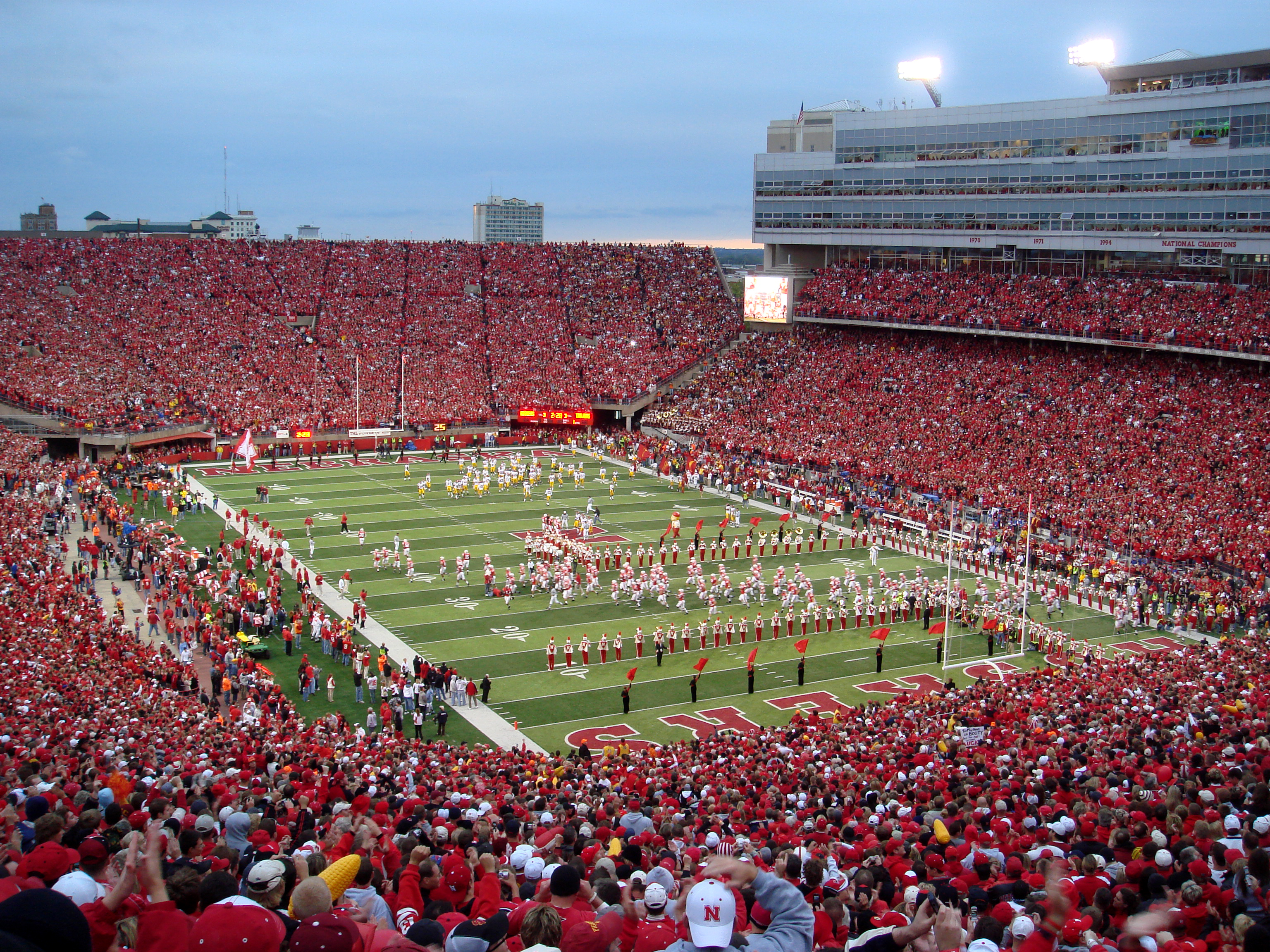
Memorial Stadium (Lincoln)
Memorial Stadium, nicknamed The Sea of Red, is an American football stadium located on the campus of the University of Nebraska–Lincoln in Lincoln, Nebraska. The stadium primarily serves as the home venue for the Nebraska Cornhuskers.
Address
600 Stadium Drive
University of Nebraska-Lincoln
University of Nebraska–Lincoln
90,000 (since 2013)[1]
92,003 (Women’s Volleyball - Aug. 30, 2023)
91,585 (Football - Sept. 20, 2014)
April 26, 1923[2]
October 13, 1923
2006
1964, 1965, 1966, 1972, 1998, 2006, 2013
$430,000 (original structure)
($7.69 million in 2023[3])
John Latenser Sr. and Sons[4]
Davis & Wilson
Earl Hawkins
Meyer & Jolly[5]
Parsons Construction Co.[6]
Memorial Stadium was built in 1923 at a cost of $450,000 and a capacity of 31,080 to replace Nebraska Field, where the Cornhuskers played home games from 1909 to 1922. The first game at the new stadium was a 24–0 Nebraska victory over Oklahoma on October 13, 1923.[7] A series of expansions raised the stadium's capacity to 85,458, but attendance numbers have in the past exceeded 90,000. Nebraska has sold out an NCAA-record 396 consecutive games at Memorial Stadium, a streak that dates back to 1962.
In 1909, the University of Nebraska constructed Nebraska Field on the corner of North 10th Street and T Street in downtown Lincoln, the school's first football-only stadium.[8] However, its wooden construction and limited seating capacity meant that after less than ten years there was significant momentum toward the building of a larger steel-and-concrete stadium for the Cornhuskers. The abrupt departure of highly successful head coach Ewald O. Stiehm temporarily slowed this momentum, but by the early 1920s, with "the present athletic field as inadequate now as the old one was in 1907," the university began plans to build a new stadium on the site of Nebraska Field.[8]
The new stadium project was initially conceived as a combination gymnasium-stadium-war museum complex to be called the "Nebraska Soldiers and Sailors Memorial."[9] Enthusiasm for the fundraising effort was high following the death of former Nebraska football captain Dusty Rhodes, who was killed in action in France during World War I.[9] Due to a slow post-war economy, the scope of the project was decreased to just a football stadium (though the Nebraska Coliseum was ultimately completed next door to Memorial Stadium just three years later). John Latenser Sr. of Omaha and Ellery Davis of Lincoln were selected as the head architects for the new stadium as they were willing to work pro bono.[9] When the fundraising target amount of $450,000 had been met, construction began and a groundbreaking ceremony was held on April 23, 1923. Construction was completed on the 31,000-seat stadium in just over ninety days, in time for NU's first home game of the 1923 season, a 24–0 win over Oklahoma on October 13. Memorial Stadium was dedicated the following week to honor Nebraskans who served in the American Civil War and the Spanish–American War, and the 751 Nebraskans who died in World War I. Later, the dedication was expanded to honor Nebraskans who died in World War II, the Korean War, and the Vietnam War.
Each corner of the stadium was given an inscription from philosophy professor Hartley Burr Alexander:[10]
The stadium, in its original layout, had open end zones and grandstands on the east and west sides of the field with seating for up to 31,080 fans.[11] A track surrounded the playing field for use by the school's track and field program.
Nebraska played on natural grass from 1923, when Memorial Stadium was completed, through 1969. In 1970,[29] as part of head coach Bob Devaney's crusade to improve athletic facilities across the university, the stadium was fit with AstroTurf, an artificial turf glued to a foam plastic layer on a six-inch (15 cm) bed of asphalt. The Huskers won consecutive national championships in 1970 and 1971.
Several iterations of AstroTurf were installed at Memorial Stadium until 1999, when it became the first Division I-A venue to install FieldTurf. A second FieldTurf installation featuring an alternating light-and-dark green pattern every five yards was installed prior to the 2005 season; at the same time, the playing surface's prominent crown was reduced. A third FieldTurf iteration was installed in 2013, featuring a "lighter and cooler" playing surface by adding cork to the traditional top layer of recycled tire pellets.
High School Championships[edit]
Since 1996, Memorial Stadium has been the host for the Nebraska School Activities Association's state high school football championship finals,[34] including smaller schools that play eight-man football, which is played on fields smaller than standard size; the state's six-man football championship finals are played at University of Nebraska at Kearney's Cope Stadium. Prior to the move to Memorial Stadium, finals for each class were contested on the home fields of the high schools involved.